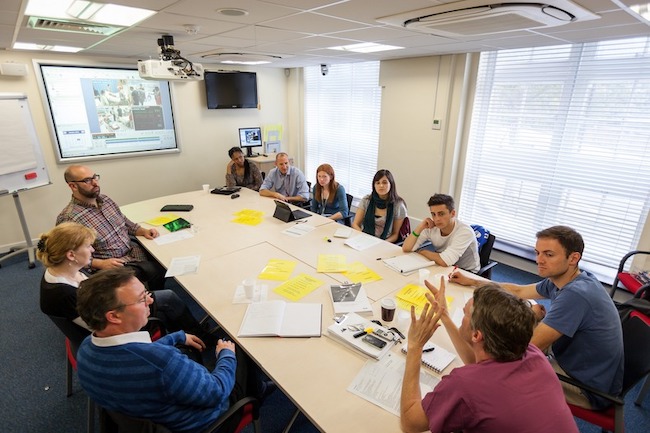Debriefing for Meaningful Learning in Nursing Simulation
The National Council of State Boards of Nursing (NCSBN) landmark study in 2014 concluded that nursing simulation could be substituted for as much as 50% of clinical hours in pre-licensure programs provided the simulation program is “high quality”. Today Dr. Kim Baily PhD, MSN, RN, CNE, previous Simulation Coordinator for Los Angeles Harbor College and Director of Nursing for El Camino College, takes a closer look at the INACSL standards on debriefing to explore how to provide meaningful feedback. Afterall, the debrief is where the real learning takes place!
Exactly what constitutes high quality healthcare simulation is the focus of much research. The International Association for Clinical Simulation and Learning (INACSL) along with the National League for Nursing and the National Council of State Boards of Nursing all recommend using theoretically derived and evidence based debriefing methods. INACSL debriefing standard – has several requirements for meeting the debriefing standard. In order for the debriefing to meet the INACSL standard, it must be:
- Based on a theoretical framework for debriefing that is structured in a purposeful way.
- Facilitated by a person(s) competent in the process of debriefing
- Conducted in an environment that is conducive to learning and supports confidentiality, trust, open communication, self-analysis, feedback, and reflection.
- Facilitated by a person(s) who can devote enough concentrated attention during the simulation to effectively debrief the simulation-based experience.
- Congruent with the objectives and outcomes of the simulation-based experience.
Debriefing for Meaningful Learning (DML) developed by Kristina Thomas Dreifuerst (Dreifuerst, K.T. The essentials of debriefing in simulation learning: A concept analysis. Nursing Education Perspectives. 2009; 30: 109–114) is a debriefing method which meets the INACSL Debriefing Standard criteria. The aim of the DML method is to foster clinical reasoning by encouraging learners to think about something in a logical, sensible way by first recalling an event and then by reflecting upon the event. Debriefers use Socratic questioning to help learners identify the frames of reference which led them to make a particular decision. Dreifuerst’s method is based on three theories:
Sponsored Content:
- Constructivism: An educational theory that involves teachers asking students supportive questions to encourage them to communicate what they are thinking and why and how to explore an aspect of something that they have not tried or thought about before.
- Schon’s theory of reflection: Includes concepts of reflection-in-action and reflection-on-action. Dreifuerst added a third reflection, “reflection beyond action” (anticipatory thinking).
- Biological Sciences Curriculum Study (BSCS) E5 learning strategy. The five components of the E5 Instructional model are engagement, exploration, explanation, elaboration, and evaluation. Dreifuerst added a sixth phase, “extend” to DML.
Debriefing for Meaningful Learning focuses on three aspects of reflection:
- Reflection-in-action focusing on critical decision-making points which emphasizes assimilation and accommodation (the process of taking in and fully understanding information or ideas).
- Reflection-on-action, focuses on things to do differently next time which emphasizes accommodation. During the DML debriefing, learners are encouraged to break down the experience with the goal of identifying correct and incorrect thinking.
- Reflection-beyond-action, which focuses on anticipation and preparing for the next clinical encounter.
Debriefing for Meaningful Learning Faculty Guide
Dreifuerst recommends that debriefing should in a comfortable, confidential environment separate from the simulation. The DML worksheets guide the debriefing process with the faculty posting notes and ideas on a white board. Learners have their own copies of the worksheets which they can take away with them for future reference. Colored markers are used to identify correct concepts versus concepts that need to be changed. The six iterative aspects of DML are:
- Engage: Learners complete the initial part of their own worksheet by themselves. They are asked to reflect about the clinical situation by naming the patient and briefly telling the patient’s story. In addition, they should note their immediate reactions to the situation, what went right and what did not.
- Explore: The group is encouraged to reflect on how each participant and faculty viewed the events, how opinions differed and where in the scenario decisions were made. Faculty guide the learners through thinking-in-action and thinking-on-action by creating a concept map that focuses on patient care. Relationships between assessments, findings, decisions, actions, and responses form the patient framework of what is expected and what is unexpected.
- Explain: Faculty and learners discuss assessments, findings, decisions, actions, and responses. Students are encouraged to challenge taken-for-granted assumptions and to consider thinking processes that include deduction, induction, analysis, and inference.
- Elaborate: The DML uses the nursing process as a framework for learners to integrate their simulation assessments and actions with patient responses and outcomes. The method uses concept mapping tools to link these components along with worksheets to review knowledge, skills, and attitudes. Students develop frames for meaningful learning by thinking-on-action.
- Evaluate: Debriefer guides learners through a series of questions to identify what did not go well, and to consider what would students do differently and why. This is a crucial step in the process since it creates a framework of knowledge which is correct and which prompts correct actions in future events.
- Extend (Thinking-Beyond-Action): Learners are encouraged by the use of “what if” questions to extrapolate to different patient situations or frames such as changes in patient assessments, diagnosis or client responses. This allows learners to anticipate actions in future events which do not exactly mimic the simulation clinical event.
Socratic Questioning: At a very basic level Socratic questioning involves asking who, what, why, where, when and how questions. These questions seek to clarify ideas, probe assumptions, provide reason and evidence, question different viewpoints and perspectives and identify implications and consequences. “Using Socratic questioning, the debriefer exposes the student’s frame of reference and taken-for-granted assumptions by revealing the relationships between the student’s thinking and actions” (Dreifuerst, 2015). The ultimate goal is to direct learners to reframe their thinking and connect thinking and actions.
Sponsored Content:
Debriefing for Meaningful Learning uses a standardized sequence for debriefing because the method provides a set structure for debriefing as well as a set of worksheets to ensure consistency amongst debriefers and debriefing sessions. The method may take more time to complete, however, the method provides an opportunity for learners to connect right thinking with right action and to reframe their thinking where necessary. The worksheets are copyrighted and must be obtained from the author.
Building a “high quality” simulation program takes time and effort. Identifying national standards such as those offered by INACSL provide a good place to start. The INACSL debriefing standard states that the debriefing faculty should be competent and knowledgeable about the debriefing framework, simulation scenario and simulation experience. There is an instrument the Debriefing for Meaningful Learning Evaluation Scale (DMLES) available for self and peer assessment of DML debriefing (Bradley et al. 2016, Bradley 2018). Faculty education and experience in healthcare simulation is a key component of a successful “high quality” simulation program. Deciding on a single debriefing method such as the DML for an entire program provides consistency for learners with different instructors and ensures that debriefing faculty are using an acceptable national standard. Further, a single debriefing method may save a simulation program money as faculty development can occur in a group situation and faculty can support one another during orientation of new faculty and ongoing faculty development. Finally, a standardized debriefing method may facilitate research.
The author wishes to thank Dr. Dreifuerst for reviewing this article!
References:
Bradley, C.S., & Dreifuerst, K.T. (2016). Pilot Testing the Debriefing for Meaningful Learning Evaluation Scale. Clinical Simulation in Nursing. 13(3), 1-4, doi:10.1016/j.ecns.2016.01.008.
Bradley, C. S. (2018). Confirmatory Factor Analysis of the Debriefing for Meaningful Learning Inventory©. Clinical Simulation in Nursing, 14, 15-20.
Read Dreifuerst’s Full Clinical Simulation in Nursing Meaningful Debriefing Article Here!
Dr. Kim Baily, MSN, PhD, RN, CNE has had a passion for healthcare simulation since she pulled her first sim man out of the closet and into the light in 2002. She has been a full-time educator and director of nursing and was responsible for building and implementing two nursing simulation programs at El Camino College and Pasadena City College in Southern California. Dr. Baily is a member of both INACSL and SSH. She serves as a consultant for emerging clinical simulation programs and has previously chaired Southern California Simulation Collaborative, which supports healthcare professionals working in healthcare simulation in both hospitals and academic institutions throughout Southern California. Dr. Baily has taught a variety of nursing and medical simulation-related courses in a variety of forums, such as on-site simulation in healthcare debriefing workshops and online courses. Since retiring from full time teaching, she has written over 100 healthcare simulation educational articles for HealthySimulation.com while traveling around the country via her RV out of California.
Sponsored Content:




















